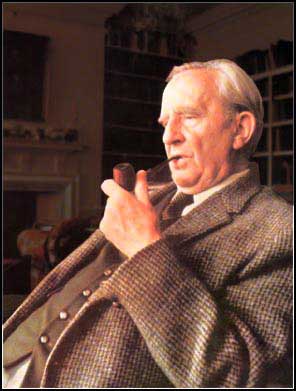|
Birmingham's Most Famous Son

|
| J R R Tolkien.1892-1973 |
A major scholar of the English language, specialising in Old and Middle
English. Twice Professor of Anglo-Saxon at Oxford University, he also wrote a number of stories, including his most famous,
The Hobbit (1937) and The Lord of the Rings (1954-1955), which are set in an invented version of our world which he called
by the Middle English name of Middle-earth. This was peopled by Hobbits, Women, Men, Elves, Dwarves, Trolls, and Orcs . He
has regularly been condemned by the Eng. Lit. establishment, with honourable exceptions, but loved by millions upon millions
of readers worldwide
John Ronald Reuel Tolkien was born in Bloemfontein, capital of the Orange
Free State in South Africa, on 3 January 1892. Both his parents were from Birmingham, but had left their native city to seek
a new life in South Africa. His father was a bank manager. Three years later, Mabel Tolkien took her two sons, Ronald and
Hilary (born two years after Ronald), back to Birmingham to see their grandparents for the first time. It was at the home
of the grandparents, at 9 Ashfield Road in Kings Heath, that Mabel Tolkien received a telegram announcing the tragic news
that her husband had suffered a severe haemorrhage and was dead.
Mabel had never liked Bloemfontein, describing it on one occassion as
'Owlin' Wilderness! Horrid Waste!'. Now with no reason to return to South Africa, Mabel and her sons settled in Birmingham,
in the small hamlet of Sarehole. Tolkien often said that the happiest years of his childhood were those he spent in Sarehole.
His mother moved there shortly after the house was built in 1896, when it was known as 5 Gracewell. The tiny village of Sarehole
is said to have been the model for The Shire, the home of the hobbits. The most exciting thing for a young boy to see in the
village was Sarehole Mill in Cole Bank Road, Hall Green. It is still there today and is Birmingham's only surviving watermill.
Ronald and his brother spent many an hour investigating the mill and being chased off by the miller's son, whom they nicknamed
the "White Ogre". There had been a mill on this stretch of the River Cole since the Middle Ages, though the present buildings
date from 1768. When the mill fell into decay, Tolkien contributed to the fund to preserve it. It is now run as a museum by
Birmingham City Museums and Art Gallery.
Once Ronald had entered King Edward's School in Birmingham, it was necessary
for the family to move closer to a tram-route to town. His rural idyll was over, but his memories of it coloured much of his
later writing. After leaving Sarehole, the family lived briefly at 214 Alcester Road, near Moseley village. It was once a
fire-station. In later life, Tolkien often lamented the encroachment of civilisation, with its trams and houses and motor
cars, upon his former home in the countryside. But there was one place that civilisation missed, the mysterious world of Moseley
Bog. This miraculously preserved haven for wildlife was an ideal place for the two boys' childhood adventures. It is recalled
in Tolkien's description of the Old Forest, last of the primeval wild woods, where Tom Bombadil lived. The Bog is now preserved
as a Nature Reserve by Birmingham City Council. From Moseley village Tolkien could catch a tram into the city of Birmingham
on his way to King Edward's School. It was here that the young boy's love of languages was allowed to flourish and grow. The
rich Victorian Gothic buildings stood in New Street, at the heart of the city centre near to the entrance to New Street Station.
(A blue memorial plaque marks the site). The school is now on Edgbaston Park Road
Around the time that Tolkien entered King Edward's
School, Mabel Tolkien and her sister May Incledon turned to Catholicism. This caused much opposition from their relations
who were ardent Baptists. It was to St Anne's Church in Alcester Street that she and her sons travelled to worship, from their
home in Moseley. The church was a new one, having been built in 1884 to replace Cardinal Newman's original chapel. Tolkien
was to remain a Catholic for the rest of his life, the faith he so strongly associated with his mother. After Moseley the
family returned to Kings Heath and lived at 86 Westfield Road. But they were soon on the move again to a house in Oliver Road,
now demolished. To save money Mabel moved her two boys to the nearby St Philips's Grammar School. However Ronald Tolkien was
to resume his studies at King Edward's the following year after winning a Foundation Scholarship. Mabel Tolkien's search for
a church that she found sympathetic led her to Cardinal Newman's community at The Oratory on the Hagley Road. At the time
of their arrival in 1902, the magnificent new church was still being built. The friendship of the parish priest, Father Francis
Xavier Morgan, was to provide an important source of strength to the family for the trials that were to follow.
It was while they were living in Oliver
Road that Tolkien's mother was diagnosed as diabetic, and in 1904, while convalescing at the Oratory retreat near Rednal,
she died. Ronald and Hilary were sent to stay with an aunt, Beatrice Suffield, at 25 Stirling Road, off the Hagley Road, where
they remained for four years. The house is still there, though Tolkien's memories of it were gloomy. Just around the corner
was a building that must have left an impression on the young Tolkien, an extraordinary 96ft (29m) stone tower known
as Perrott's Folly. It was built in 1758 by John Perrott and is Birmingham's oddest architectural feature.
Near it stands a later tower,which is part of the Victorian Era built Edgbaston Waterworks, and the pair are said to have suggested Minas Tirith and Minas Morgul, the Two
Towers after which the second volume of the Lord of the Rings is named. During his time in Birmingham many other ideas sank
into the mind of the future novelist, to surface many years later. Tolkien probably came across the word Gamgee as the local
name for cotton wool: Gamgee tissue. The inventor was a Birmingham doctor and surgeon, Dr Joseph Sampson Gamgee, who lived in the city until his death in 1880 at his house in Broad Street. Locally
he is famous as the founder of the Hospital Saturday Fund. Tolkien used the name Sam Gamgee in Lord of the Rings for Frodo's
faithful companion and the last of the ring-bearers. Ronald Tolkien lodged for a while in Duchess Road where he met and fell
in love with Edith Bratt, who was later to become his wife. But Tolkien was still only 16 at the time and his guardian Father
Morgan, on discovering of their love affair following a clandestine bicycle trip, tried to put an end to the relationship.
Ronald and his brother were found new lodgings in 4 Highfield Road and Ronald was forbidden to see or speak to Edith who was
taken off to Cheltenham.
This was to be his last permanent
address in Birmingham for it was here that Ronald heard that he had won an exhibition to Exeter College, Oxford, to study classics. While Ronald was at Oxford, Edith became engaged to a Warwickshire
farmer but she later ditched him when Ronald reached 21 in January 1913. It was only two weeks before the wedding that Ronald
plucked up the courage to write and tell Father Francis that he was to marry Edith. Father Francis was happy for them both
and offered to conduct the wedding ceremony himself at the Oratory, but the offer came too late: they had made other arrangements.
On Wednesday 22 March 1916 Ronald and Edith were married at the Roman Catholic Church of St Mary Immaculate in Warwick, and
spent their honeymoon in Clevedon, Somerset. On June 2 Ronald, newly commissioned in the Lancashire Fusiliers, received the
telegram ordering him to embark for France. They spent their last night before his departure, possibly thinking it might be
their last together, at the Plough and Harrow Hotel on the Hagley Road in Birmingham. Tolkien survived the Battle of the Somme, where two of his three closest friends were killed, but later that year he was struck
down by trench fever and invalided back to England.With the exception of this army service and a spell as lecturer at Leeds
University he and Edith were to spend most of the rest of their lives in Oxford.
The years after the Great War were devoted to his
work as an academic: as a Professor of Anglo-Saxon at Oxford, where he was soon to prove himself one of the finest philoligists
in the world. He had already started to write a great cycle of the myths and legends of Middle Earth which was to become the
Silmarillion. He and Edith had four children and it was for them that he first told the tale of Bilbo Baggins, The Hobbit,
published in 1937 by Sir Stanley Unwin. The Hobbit proved to be so successful that Unwin was soon asking for a follow up,
he began work on Lord of the Rings, but it was not until 1954, when Tolkien was approaching retirement, that the first two
volumes, The Fellowship of the Ring and The Two Towers were published, The third part, The Return of the King, was published
in 1955, its success took him by surprise. After retirement Ronald and Edith moved to Bournemouth, but when Edith died in
1971, Ronald returned to Oxford. He died after a brief illness on 2nd September 1973, leaving his great mythological work,
The Silmarillion, to be edited for publication by his son, Christopher.

|
| Moseley Bog |
This page can also be found on our
|



